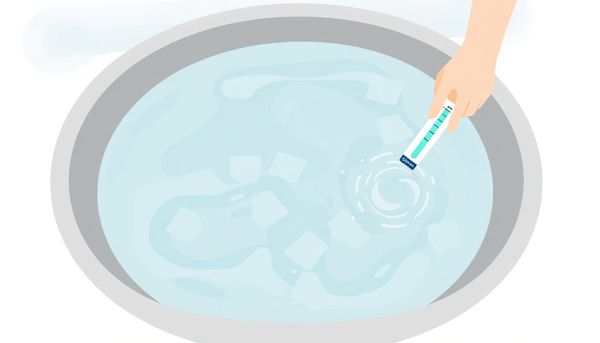Attain Sparkling Hot Tub Water: Pro Tips to Banish Cloudiness
November 24th, 2024
November 24th, 2024
The allure of slipping into a hot tub is undeniable: soothing jets and warm water melting away stress. Yet, nothing dampens this blissful retreat quicker than murky, uninviting water. Clarity in your hot tub isn’t just an aesthetic preference; it speaks to the cleanliness and safety of the water you immerse yourself in. Many hot tub enthusiasts have experienced the frustration of cloudiness, only to turn to a myriad of solutions that promise results but deliver tardiness.
I recall a time when I hosted a small gathering at home. The hot tub, usually the highlight, was far from its sparkling self that evening. With guests arriving in a couple of hours, panic set in. This was a situation where clarity was not just preferred—it was necessary. If I had known then what I know now, clearing that cloudy water would have been a breeze.
The process of transforming your hot tub from murky to crystal clear isn’t as daunting as one might assume. With a few effective strategies and the right approach, the water can regain its inviting clarity in under an hour. This guide is crafted to equip you with practical steps and insights gleaned from personal experiences and expert advice, ensuring that your hot tub remains a pristine sanctuary, ready for relaxation at a moment’s notice.

Balancing and shocking your hot tub can feel like a magic trick, transforming murky water into a sparkling oasis. Begin by testing your water's pH and alkalinity levels, crucial elements that can waver with usage. On one memorable occasion, I discovered my pH had swung wildly after hosting a backyard party. A quick adjustment with a pH decreaser brought tranquility back to my tub. Aim for a pH of 7.4 to 7.6 and an alkalinity of 100 to 150 PPM. These are the sweet spots where your sanitizer can perform its best.
Once balanced, it's time to shock the system. Picture it as a wake-up call for your sanitizer. I recall the first time I misunderstood this step, using the wrong type of shock, and ending up with even cloudier water. Lesson learned! Use chlorine shock if your levels are low, especially after heavy use. It’s potent and effective. Non-chlorine shock, on the other hand, is less aggressive and perfect for weekly maintenance to refresh your bromine or chlorine levels.
Remember, patience is key. Allow at least 20 minutes after shocking before retesting, ensuring your levels have stabilized. For a final touch, keep your hot tub running and filtering continuously for the next 24 hours. This ensures that every lingering particle gets caught in the filter, and your water remains pristine.
As a hot tub owner, encountering cloudy water can feel like a mysterious riddle, but understanding the root causes brings clarity. The usual suspects causing this muddle often stem from unbalanced water chemistry or external pollutants. Consider the last party you hosted; while friends enjoyed the warm soak, sweat, body oils, and other personal care products may have joined the fun, overwhelming your sanitizer and leading to cloudiness.
Similarly, your hot tub's filtration system acts as the unsung hero, keeping your water pristine. However, when filters become clogged with debris or improperly installed, they fail to trap microscopic particles that cloud your water. Imagine your filter as a security guard at a concert, allowing only the cleanest guests through. If the guard slacks off, chaos ensues.
Moreover, the chemistry of your water plays a crucial role. High pH and alkalinity levels might silently contribute to calcium buildup, turning your hot tub into a cloudy cauldron. Regular testing and balancing can prevent these sneaky culprits from spoiling your oasis.
Lastly, lurking in the depths of your plumbing lies the biofilm—a stubborn buildup resistant to standard cleaning methods. Like an unwelcome houseguest that refuses to leave, biofilm needs a targeted flush solution to evict it from the premises.
Understanding these causes not only helps in addressing the immediate cloudiness but also in preventing future water woes, ensuring that your hot tub remains a clear, inviting retreat.
Cloudy hot tub water is a common nuisance, but the solution often lies in restoring a harmonious chemical balance. Begin by reaching for those trusty test strips or a liquid test kit. Checking the water's chemistry is like peering into the heart of your hot tub—it reveals the intricate dance of pH, alkalinity, and sanitizer levels that keep your water clear and inviting. Ideally, pH should nestle between 7.4 and 7.6, while alkalinity should find its home around 100 to 150 PPM. Deviations from these numbers can prompt cloudy conditions or even scale buildup, which is less than ideal for a relaxing soak.
Once you've tested, it's time to adjust. Alkalinity acts as a buffer for pH, so start there. If you find it straying from the recommended range, use a pH increaser or decreaser accordingly. This stabilizes the environment, making it conducive for sanitizers like chlorine or bromine to perform efficiently. Don't rush—give the water a good 20 minutes post-adjustment to settle before rechecking.
Equally crucial is maintaining the sanitizer levels. Chlorine and bromine should be kept at 1-3 PPM and 3-5 PPM, respectively. If they're low, your hot tub becomes a breeding ground for contaminants. A carefully measured dose of chlorine shock can work wonders, not only tackling cloudiness but ensuring any lurking bacteria or algae are kept at bay. Such diligence, paired with routine checks, transforms your hot tub from a murky mystery into a crystal-clear oasis, perfect for unwinding.
Sanitizers in a hot tub aren't just a luxury—they're your first line of defense against murky waters. When faced with cloudy water, the immediate instinct might be to up the chlorine, but the real trick lies in revitalizing your sanitizer with a shock treatment. This isn't just about dumping chemicals; it's an art that balances precision and patience.
I remember last summer, a friend had a get-together, and the once crystal-clear water turned into a soupy mess after a day of sunblock and splashes. My well-trusted solution was a double hit—chlorine shock for immediate relief and non-chlorine shock to maintain clarity. The transformation was nothing short of magic; within an hour, the water regained its sparkle.
Using a non-chlorine shock weekly works wonders in keeping your sanitizer active. This step is crucial, especially after heavy usage, when oils and lotions have settled in. It's like giving your sanitizer a caffeine boost, enabling it to tackle contaminants effectively.
Should your hot tub become a social hub, it’s wise to test and balance the water regularly. Make it a ritual—like setting the table before a feast. And remember, shocking isn’t just reactive; it’s preventative. By keeping these practices in your routine, not only do you fend off cloudiness, but you also extend the life and enjoyment of your watery retreat.

In the world of hot tub maintenance, dealing with biofilm buildup can feel like battling an invisible enemy. This stubborn layer of bacteria and organic material forms inside your pipes, creating a protective shield against regular sanitizers like chlorine or bromine. When left unchecked, it not only contributes to cloudy water but can also lead to unpleasant odors and potential health risks.
Several years ago, while assisting a friend with their hot tub dilemma, we discovered the formidable nature of biofilm. Despite balancing the water chemistry and cleaning the filters, the water remained murky. It wasn’t until we used a hot tub line flush cleaner that the real culprit was revealed—a foamy mess of biofilm breaking free from the hidden recesses of the plumbing. The transformation after flushing was astonishing; the water turned crystal clear, and the spa experience was rejuvenated.
To tackle this issue effectively, incorporate a line flush treatment into your maintenance schedule every three to four months. Begin by adding the flush product to your full hot tub, allowing it to circulate for at least 30 minutes. During this process, you might notice discolored, foamy water as the biofilm is dislodged and flushed out. Once complete, drain your hot tub, clean the shell, and refill it with fresh water. By making this practice a routine, you ensure that your soaking sessions remain pristine, without the intrusion of unseen contaminants.
Balancing the water chemistry in your hot tub is like fine-tuning an orchestra. Each element must harmonize perfectly to create a clear, inviting pool of water. The first note to strike is testing the water's pH and alkalinity. You want to aim for a pH of 7.4 to 7.6 and an alkalinity between 100 to 150 PPM. If these levels are off, your chlorine or bromine won't have the right environment to do its job effectively. It's similar to baking: too much of one ingredient and your cake—much like your water—can turn out less than ideal.
For example, when my hot tub started resembling a foggy day in London, a quick test revealed my pH had skyrocketed. A bit of pH decreaser later, and the water clarity was returning to its serene state. This is a testament to the impact of precise chemical balance.
After ensuring your pH and alkalinity are spot on, focus on your sanitizer levels. Chlorine should sit between 1 and 3 PPM, while bromine does better between 3 and 5 PPM. These levels ensure the destruction of unwanted guests like algae and bacteria. A weekly non-chlorine shock can rejuvenate your sanitizer, keeping it primed and effective. Imagine it as a coffee break for your water, boosting its energy to tackle impurities.
By maintaining these chemical symphonies within your hot tub, you're not just clearing up today's cloudiness but also setting the stage for consistently crystal-clear waters in the future.
A hot tub, much like a cherished garden, demands regular attention to avoid becoming overrun with unwanted elements. One of the best tools in your maintenance arsenal is shock treatment, akin to hitting the reset button on your water's purity. Regularly applying shock treatments is a proactive measure to tackle not just the visible cloudiness but also the invisible culprits lurking in the water. This is not about battling current problems alone; it’s about preventing future murkiness from even thinking about setting in.
Recall the last time you hosted a barbecue, and everyone enjoyed a dip afterward. The lotions, sweat, and oils from a single gathering can overwhelm your sanitizer. A generous dose of shock treatment acts like an invisible hand sweeping away the aftermath, breaking down contaminants before they morph into stubborn troublemakers. On a weekly basis, and especially after heavy use, a non-chlorine shock can revitalize your primary sanitizer, ensuring it continues to perform its duty with vigor.
Don't let this task slip into the abyss of forgotten chores. Just as you wouldn’t skip oil changes for your car, regular shock treatments are essential for maintaining water clarity and quality. With this step included in your hot tub care routine, you’re ensuring every soak is a pristine escape, free from the cloudiness that can mar your relaxation. So, arm your tub with a routine that promises clarity: shock it regularly and step into clear, inviting waters every time.
Tackling the often-overlooked internal enemy of your hot tub, biofilm, is key to ensuring pristine water quality. The silent invader, biofilm, thrives within the intricate maze of your hot tub's plumbing. Over time, it forms a stubborn barrier, resisting even the most diligent application of sanitizers like chlorine or bromine. It's easy to miss, but this accumulation is a common culprit behind the persistent cloudiness of your water.
To combat this, a thorough line flush becomes essential. Think of it as a deep cleanse for your pipes, akin to unclogging a drain that's seen too many soap suds and hair. Every three to four months, make it a ritual to employ a hot tub line flush product. Pour it in and let the jets run their course for a good half-hour or as directed, watching as the water foams and bubbles, revealing the hidden grime.
Once the flush has worked its magic, it's time to drain the tub. This is the moment where you unveil the true brilliance of your spa’s surfaces, free from the murky film that's been shadowing it. Refill with fresh water, and you've effectively reset your hot tub to its original clarity, ready to deliver the relaxation you deserve. Keeping this routine ensures that your hot tub not only looks inviting but also maintains a hygienic and enjoyable soaking experience.

Grabbing a towel and heading for a soak, only to find your hot tub water cloudy, can be a real downer. A dirty filter might just be the culprit. Filters are like the lungs of your hot tub; they breathe in particles and debris, capturing all sorts of unwanted intruders. Yet, over time, these filters can become overwhelmed, and when they’re clogged, they become ineffective. A routine cleaning and replacement regime is crucial to maintain clear water.
First up, a good rinse with a garden hose works wonders. Aim to do this weekly, gently spraying the filter to dislodge dirt and gunk. Monthly, it’s time for a deeper dive: utilize a filter cleaning solution to soak the cartridge overnight. This helps break down oils and organic matter that a simple rinse might miss. As someone who’s tried to stretch a filter’s lifespan too far, I can attest that a neglected filter doesn’t just cloud your water; it can lead to more significant maintenance issues.
Checking the filter’s condition is just as essential. If you notice any tears or a graying surface, it's time for a replacement—no amount of cleaning can resurrect a worn-out filter. Keep a spare on hand, so during cleaning, your hot tub doesn't sit idle. This small habit ensures your tub is always ready for that impromptu relaxation session and keeps the water invitingly clear.
Think of your hot tub filter as the unsung hero of your spa experience. While it may sit quietly on the sidelines, it plays a crucial role in keeping your water crystal clear. When left unattended, however, a dirty or clogged filter can quickly become the villain, allowing debris and microscopic particles to cloud your hot tub water.
In my early days of hot tub ownership, I overlooked the importance of regular filter maintenance. After a particularly busy weekend with friends, I noticed the water turning murky. It was then that I discovered the magic of a clean filter. A simple rinse with a garden hose can work wonders, but for a truly deep clean, monthly treatment with a specialized filter cleanser is essential. This not only removes dirt and oils but also extends the life of your filter.
Equally important is ensuring the filter is properly seated in its housing. This small step guarantees that water is effectively being filtered. And don't fall into the trap of thinking a filter lasts forever; when it shows signs of wear or refuses to come back to life after cleaning, it's time for a replacement. Keeping a spare on hand ensures you're never caught off guard.
By prioritizing regular filter maintenance, you're taking a proactive step in preventing cloudy water disasters and ensuring your hot tub is always ready for relaxation.
Filters, the unsung heroes of any hot tub, bear the brunt of trapping dirt, debris, and invisible particles. Over time, these diligent defenders can become clogged and ineffective, turning your pristine oasis into a murky mystery. I recall a time when my own hot tub resembled a forgotten pond rather than a luxurious retreat. After some investigation, the culprit was a weary filter long past its prime.
Changing your filter is akin to replacing old running shoes; eventually, the wear and tear become undeniable. Start by removing the filter cartridge and giving it a decent rinse with a garden hose. This initial rinse dislodges surface debris, but a monthly soak in a dedicated filter cleaner will tackle stubborn buildup. Despite regular cleaning, filters do have a lifespan. If your cartridge appears more tired than vibrant or shows signs of tearing, it’s time to invest in a new one.
Replacing a worn-out filter can make a world of difference. When my hot tub water started to resemble a cauldron of confusion, switching to a fresh filter restored its crystalline charm in no time. Keep a spare cartridge handy—this ensures your tub remains inviting even while cleaning the primary filter. Not only does this keep the water clear, but it also improves the efficiency of your chemicals, allowing them to do their job without a hitch.
Understanding the mystery of foggy hot tub water often boils down to one crucial aspect: water chemistry. Mastering this can mean the difference between a quick fix and ongoing frustration. Remember that time I thought I could skip a week of testing? My relaxation sanctuary turned into a murky mystery. Balancing your water is like tuning a musical instrument; each component must harmoniously align.
Begin by addressing total alkalinity, the unsung hero of stabilization. Ideal levels hover between 100 and 150 PPM. Adjust this first to ease the next step: pH balancing. Aim for a pH of 7.4 to 7.6. Too high, and you’re inviting cloudy water and irritating skin. Too low, and you risk corrosion. I once overlooked this balance, and my hot tub became a chemistry experiment gone awry.
Each time you add chemicals, remember this: patience is key. Allow 20 minutes for them to mingle before retesting. This ensures precision and saves you from overcorrection. My friend, who learned this the hard way, ended up with a foam party instead of a soothing soak. For those who encounter high calcium hardness or metals in their water, a pre-filter on the garden hose can prevent cloudiness from the start.
Return weekly to this ritual, especially after heavy use, to maintain clarity. With these practices, your hot tub remains a clear oasis amidst life’s chaos, restoring the peace you sought when you first dipped into its inviting waters.

Balancing pH levels in your hot tub is like fine-tuning an instrument. Just a slight imbalance, and the harmony of your spa can quickly turn into a murky mess. The ideal pH range, sitting comfortably between 7.4 and 7.6, ensures that your hot tub water is not only clear but also safe for skin and hot tub components. Achieving this range requires a bit of chemistry but is a task even the most novice hot tub owner can master with ease.
Begin by using a reliable test kit. While strips are convenient, a liquid test kit offers more precision. Once you've established your pH level, adjustments can be made based on the results. If your pH reads too high, introducing a pH decreaser will help bring it down to that sweet spot. Conversely, if it's too low, a pH increaser is your friend. Always add chemicals with the jets on and the cover off, letting the water circulate for about 20 minutes before retesting.
My friend once struggled with stubborn cloudiness and quickly realized the culprit was a consistently high pH level. A few small tweaks and regular testing turned his hot tub from a foggy haze into crystal-clear bliss. Remember, consistent monitoring and adjustment are key. Not only does it ensure clarity, but it also enhances the efficacy of your sanitizer, making your hot tub experience all the more pleasurable. So, with a bit of patience and practice, maintaining balanced pH levels becomes second nature, keeping your spa inviting and gleaming.
Once upon a time, in the realm of hot tub bliss, maintaining crystal-clear water was a mystical art, often disrupted by the ever-looming threat of cloudiness. Balancing alkalinity is akin to wielding the magic wand that keeps your tub enchanting and inviting. It's not just about aesthetics; it's about ensuring the water feels comfortable and doesn’t irritate your skin or damage your hot tub.
Alkalinity acts as the backbone of water chemistry, buffering pH levels and keeping them in check. Without this stabilizing influence, your pH could swing like a pendulum, leading to conditions ripe for cloudy water. Imagine an orchestra without a conductor; chaos ensues. Similarly, when alkalinity is out of balance, your hot tub can become a breeding ground for scale buildup and ineffective sanitization.
Remember the first time you faced this challenge? A friendly neighbor suggested a simple fix: test and adjust. Begin with a reliable test strip or liquid kit, ensuring your alkalinity hovers between 100 to 150 PPM. If it strays too high, a pH decreaser can gently nudge it back into harmony. With this, the pH naturally aligns, typically settling around 7.4 to 7.6—perfect for keeping murkiness at bay.
By mastering alkalinity, you not only preserve the serenity of your hot tub but also prolong its life, saving both time and resources. With balanced water, every soak becomes a peaceful escape, free from the ghosts of cloudiness past.
There's a certain magic in watching a clear hot tub bubble with inviting warmth, but when that clarity vanishes into a murky haze, it can be quite disheartening. A powerful tool to reclaim that pristine sparkle is shock treatment. Think of it as a superhero for your water, swooping in to save the day by eliminating those troublesome particles and invisible villains.
Shocking your hot tub involves introducing a concentrated dose of chemicals—commonly either chlorine or non-chlorine options—that work to break down organic compounds, eliminate bacteria, and revive your sanitizer. This process is crucial, especially after heavy use or if the tub has been neglected for some time. Not only does it target contaminants like body oils, lotions, and other residues, but it also clears up the cloudiness that may have resulted from these unwelcome guests.
During a recent weekend soak, after hosting a gathering of friends, I noticed that my hot tub water had taken on a foggy appearance. After testing and balancing the basics—pH and alkalinity—I reached for the chlorine shock. With the hot tub jets running and the cover off, I carefully measured and added the shock. Within minutes, the transformation began. By the end of the hour, my tub was a shimmering oasis once more.
It’s essential to keep your tub running and filtering for several hours post-shock to ensure every last impurity is whisked away. Regularly incorporating shock treatment into your hot tub routine can prevent cloudiness from becoming a recurring guest and maintain that crystal-clear allure everyone loves.
Biofilm build-up in your hot tub resembles an unwelcome guest who lingers long after the party's over. These sticky communities of bacteria and organic matter thrive in the nooks and crannies of your tub’s plumbing system, causing cloudiness that regular maintenance can't touch. When I first discovered biofilm in my own hot tub, it felt like trying to catch smoke with bare hands; invisible yet stubbornly resistant to typical cleaning methods.
Addressing this sneaky issue requires a little more elbow grease and a specific approach. Begin with a hot tub line flush cleaner, a product designed to dislodge biofilm from its covert hideouts. The first time I used a line flush, the transformation was akin to unclogging a drain—satisfying as the murky water swirled out, revealing clearer pipes. You might notice foamy, grimy water emerging as the biofilm breaks free. It's a sight that, oddly enough, brings peace of mind, knowing that the unseen enemy is being banished.
Executing this deep cleaning every three to four months can significantly improve your water clarity. Following the flush, drain the tub, scrub the interior shell, and refill with fresh, filtered water. Regularly repeating this process not only keeps your hot tub inviting but also prolongs the life of your equipment. By keeping biofilm at bay, you're ensuring that your next soak is as rejuvenating as intended, not a murky mystery.

Metal contaminants, though invisible to the naked eye, can play havoc with your hot tub’s crystal clarity. Remember the last time you filled your tub from a garden hose, thinking it was just water? Well, along with it came trace metals like iron and copper. Over time, these metals can react with your other chemicals, leading to stubborn stains and murky water. It’s akin to watching a pristine pond turn into a swamp after a rainstorm.
A friend once shared her story of an unexpected hot tub party disaster. Her guests were ready to plunge in, only to be met with water that resembled murky soup. The culprit? Metals lurking in the water source. This is where a metal sequestrant becomes your unsung hero. By binding with the metals, it prevents them from causing mischief in your water. Adding it during each refill ensures that metal particles don’t get a chance to settle in for the long haul.
In addition to using a sequestrant, consider employing a hose filter when filling up your hot tub. This simple step acts as a first line of defense, straining out unwanted minerals before they even get a chance to mingle. Regular maintenance, paired with these smart practices, helps preserve your hot tub’s water clarity, allowing you to enjoy endless, cloud-free soaks.
In the battle against cloudy hot tub water, metal sequestrants are like unsung heroes. They do the behind-the-scenes work that keeps your spa looking pristine, focusing on the often-overlooked culprits: metals. Many hot tub owners unknowingly fill their tubs with water that contains traces of metals such as iron and copper. These metals can not only cloud your water but also cause unsightly stains on your hot tub surfaces. Enter the metal sequestrant—a chemical that binds with these metals, rendering them harmless.
Incorporating a metal sequestrant is straightforward and efficient. When you fill your hot tub, add this chemical before introducing other water treatments. This ensures that any potential metallic interference is neutralized from the start. Regular maintenance is equally important. Even if your source water seems fine, periodic use of a sequestrant can prevent the gradual accumulation of metals, which might otherwise lead to problems down the line.
A friend once shared her experience of battling inexplicable cloudiness in her hot tub. It turned out that her seemingly clean water source had a high metal content. A simple introduction of a metal sequestrant transformed her murky woes into crystal-clear bliss. Remember, while filters and shocks handle the visible and organic debris, metal sequestrants tackle the invisible metallic threats. This dual approach ensures your hot tub remains inviting and spotless, allowing you to sink into relaxation without a second thought.
Filters are the unsung heroes in the battle against cloudy hot tub water. Regular filter maintenance is crucial; it’s like giving your tub a chance to breathe without choking on debris. Once, I neglected my filter for just a couple of weeks, and the water turned from crystal clear to murky, resembling a forgotten fish tank. Lesson learned: a clean filter is a happy hot tub.
Start by making it a habit to rinse your filter weekly with a garden hose. This simple act removes larger debris and keeps the system running smoothly. For a deeper cleanse, soak the filter in a cleaning solution monthly. I recall a friend’s amazement when she saw how new her filters looked after a good soak—they sparkled like they’d just been unboxed.
Testing is equally vital. The chemistry of your water can change quickly, especially after heavy use. Grab some test strips or a liquid kit and check your water at least once a week. Aim for a pH level between 7.4 and 7.6, and ensure your alkalinity is balanced. Keep a log of your test results; it’s a handy way to track any recurring issues.
Incorporating these regular checks and maintenance routines not only ensures clear water but extends the lifespan of your hot tub's components. It’s like a mini spa day for your spa—simple, effective, and oh-so-necessary.

This article provided insights into maintaining your pool. Start your pool care journey today!
Want to become a pool maintenance expert? Our free Pool School course covers everything you need to know about pool care. From basic maintenance to advanced troubleshooting, you'll learn how to:
Join over 10,000 pool owners who have already transformed their pool care routine. Get started with our free Pool School course today!